Your browser does not fully support modern features. Please upgrade for a smoother experience.
Please note this is an old version of this entry, which may differ significantly from the current revision.
Subjects:
Others
The concept of the circular economy (CE) has gained importance worldwide recently since it offers a wider perspective in terms of promoting sustainable production and consumption with limited resources. However, few studies have investigated the barriers to CE in circular food supply chains.
- circular economy
- food supply chain
- industry 4.0
- sustainability
Note: The following contents are extract from your paper. The entry will be online only after author check and submit it.
1. Introduction
According to the UN’s Food and Agriculture Organization, one third of food produced is lost or wasted every year [1]. The report also notes differences between low- and medium-, and high-income countries in terms of the losses at various stages of supply chains. In low- and medium-income countries, food loss mostly occurs at the beginning of the production and supply chains whereas food in high-income countries is thrown away by retailers or consumers to become food waste at the consumption stage [1]. Additionally, the reasons for food losses and waste vary by countries’ income level. In low-income countries, the causes are mostly related to financial restrictions and lack of technical knowledge in harvesting techniques and infrastructure whereas in medium or high-income countries the causes are connected to consumer behaviors and lack of coordination among stakeholders in the food supply chain.
Overall, increasing food waste is becoming a global issue regarding food security, which requires simultaneous management of environmental, economic, and social impacts. In order to eliminate these impacts, it is crucial to create a more sustainable food supply chain. Therefore, the concept of the CE has recently emerged as a response to the current linearity of the food supply chain. It offers an alternative method to the unsustainable linear economic model, which is identified with the ‘take, make, and dispose’ trilogy [2]. Moreover, increasing urbanization poses new challenges globally. More than half of the world’s population already live in urban areas, and this proportion is anticipated to rise to 80% by 2050 [3]. Meanwhile, the tremendously increasing world population increases demand for resources in urban regions as well as causing environmental problems, socio-economic inequalities, and new energy needs [4].
As a sustainable economic method, CE reduces the extraction of raw materials and enables recirculation of resources, thereby creating advantageous environments for both societies and industries. [5]. Among the many aims of CE, the most important is keeping materials available to decrease waste and energy use instead of disposing of them [6]. However, implementing CE requires both radical alternative economic solutions and novel management of resources [7]. CE mainly aims to resolve problems of resource use, waste, and emissions throughout the supply chain. These goals can be achieved by offering products, components, and materials with the minimum possible waste or even zero waste [8,9,10].
The transition from a linear economy to CE has created many requirements, such as increasing product reliability and quality [11]. Due to increased forward and reverse activities in the supply chain, businesses also need to adapt themselves to manage these dynamic characteristics and deal with multiple stakeholders and unpredictable conditions. To achieve CE, it is necessary to deal with various obstacles, such as strict legal regulations, high technology investment, company corporate culture, and insufficient knowledge of CE. While moving towards CE, many business models require a fundamental change to find new sustainable solutions. Businesses must therefore understand and overcome the challenges and barriers of CE to ensure sustainable development.
Despite its importance, few studies have integrated CE philosophy into the food supply chain [12,13]. It is also necessary to analyze the challenges during the transition to CE. While some studies have investigated obstacles to CE implementations [14,15,16], few studies have considered how digital technologies can be used to tackle CE barriers. Therefore, it is important to fill this gap [17]. Accordingly, this paper systematically analyzes the barriers to implementing CE in the food supply chain. It is important to understand current challenges, as viewed by industry, academics, and policymakers, to encourage future research, support companies, and determine the necessary regulations to move towards CE. Then, the importance of digital technologies is presented in order to overcome CE barriers.
The main research objectives of this study are as follows:
- -
-
To investigate the key barriers when implementing CE dimensions in the food supply chain;
- -
-
To systematically categorize CE dimensions for the food supply chain to overcome challenges;
- -
-
To analyze interaction effects between CE dimensions and food supply chain stages and between CE dimensions and sub-sectors of the food industry;
- -
-
To determine the benefits of digital technologies to overcome CE challenges in the food supply chain.
2. Analyses of CE Barriers in the Food Supply Chain
The analysis was based on the distribution of years, methodology used, keywords, focused areas, CE dimensions, stage of food supply chain, sub-sectors, adoption of CE dimensions, representation of continents and regions, interaction between methods and CE dimensions, and interaction between CE dimension and research focus considering barriers of CE dimension in the food supply chain.Regarding the distribution of journals (Figure 1), authors most commonly preferred the Journal of Cleaner Production (20%), which mainly focuses on cleaner production, sustainability, and environmental science issues. Other high-impact journals, such as Sustainability and Waste Management, also focus on topics related to CE and sustainability.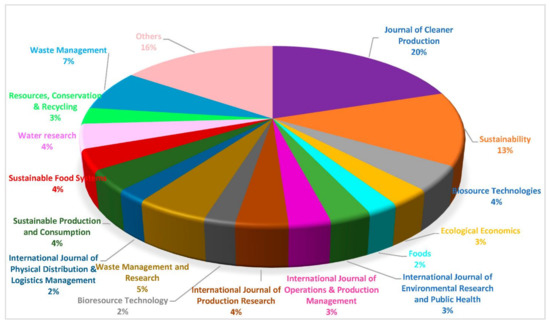 Figure 1. Distribution of journals.Regarding the distribution of articles over time (Figure 2), CE-related articles increased rapidly between 2016 and 2019. Thus, sustainability and CE in the food supply chain has undoubtedly become a prominent issue during the last 10 years and attracted the attention of researchers, especially regarding CE-related barriers and practices in food supply chains.
Figure 1. Distribution of journals.Regarding the distribution of articles over time (Figure 2), CE-related articles increased rapidly between 2016 and 2019. Thus, sustainability and CE in the food supply chain has undoubtedly become a prominent issue during the last 10 years and attracted the attention of researchers, especially regarding CE-related barriers and practices in food supply chains.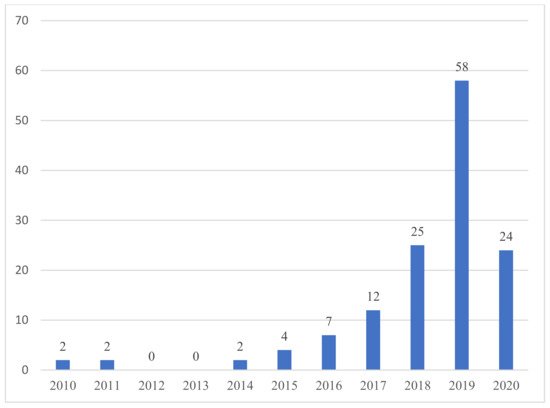 Figure 2. Number of publications over years.As Figure 3 shows, researchers generally preferred qualitative approaches. The three most commonly used qualitative methods were systematic literature review, case studies, and interviews.
Figure 2. Number of publications over years.As Figure 3 shows, researchers generally preferred qualitative approaches. The three most commonly used qualitative methods were systematic literature review, case studies, and interviews.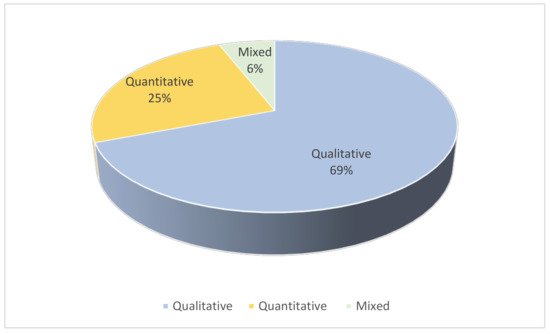 Figure 3. Methods used in publications.Figure 4 shows the distribution of studies according to their focus on specific CE dimensions based on the 9R framework. CE can be achieved by adapting 9R principles to the supply chain. The most frequently mentioned dimension was “rethinking”, which indicates that overcoming CE barriers requires rethinking at the design stage. The three most frequently mentioned CE dimensions were rethink (28%), recycle (17%), and reuse (16%) whereas the three least frequently mentioned were repair (1%), refurbish (2%), and recover (6%).
Figure 3. Methods used in publications.Figure 4 shows the distribution of studies according to their focus on specific CE dimensions based on the 9R framework. CE can be achieved by adapting 9R principles to the supply chain. The most frequently mentioned dimension was “rethinking”, which indicates that overcoming CE barriers requires rethinking at the design stage. The three most frequently mentioned CE dimensions were rethink (28%), recycle (17%), and reuse (16%) whereas the three least frequently mentioned were repair (1%), refurbish (2%), and recover (6%).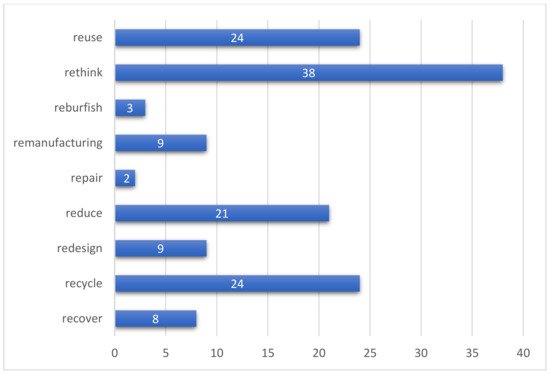 Figure 4. Number of publications based on CE dimensions.Regarding supply chain stages (Figure 5), most articles (90) focused on consumption, followed by collection (15) and food processing (9). It is worth noting that no articles about barriers to CE in food supply chains focused on ‘farm to factory’, ‘from production facility to retail’, and ‘packaging’. Similarly, ‘reverse logistics’, ‘retail to market’, ‘harvesting’, and ‘collection’ received minimal attention. This finding indicates that more research is needed into certain food chain stages to identify all the barriers to applying CE.
Figure 4. Number of publications based on CE dimensions.Regarding supply chain stages (Figure 5), most articles (90) focused on consumption, followed by collection (15) and food processing (9). It is worth noting that no articles about barriers to CE in food supply chains focused on ‘farm to factory’, ‘from production facility to retail’, and ‘packaging’. Similarly, ‘reverse logistics’, ‘retail to market’, ‘harvesting’, and ‘collection’ received minimal attention. This finding indicates that more research is needed into certain food chain stages to identify all the barriers to applying CE.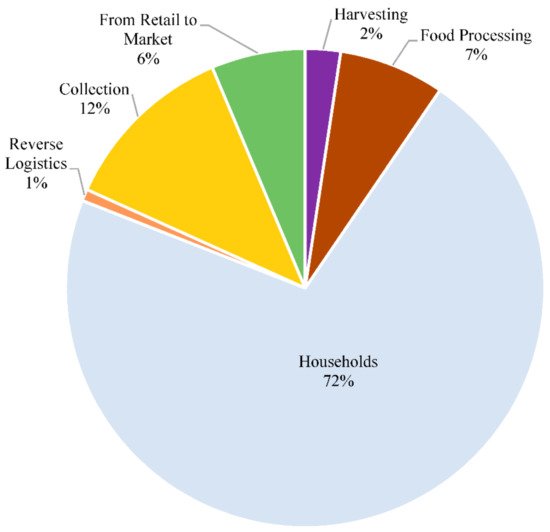 Figure 5. Distribution of articles focused on specific supply chain stages.Figure 6 shows which food sub-sectors have adopted CE dimensions in their food chains. The top sub-sector was fruit and vegetables (32%), followed by milk and meat (24%), wine (20%), sugar (12%), and coffee (12%).
Figure 5. Distribution of articles focused on specific supply chain stages.Figure 6 shows which food sub-sectors have adopted CE dimensions in their food chains. The top sub-sector was fruit and vegetables (32%), followed by milk and meat (24%), wine (20%), sugar (12%), and coffee (12%).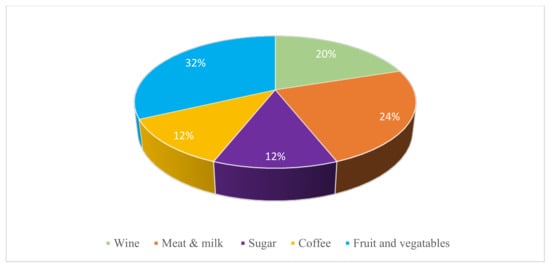 Figure 6. Distribution of food sub-sectors adaptation of CE dimensions.Figure 7 shows the methodology used for studies of specific CE dimensions. Confirming Figure 5, qualitative methodology is most frequently used across all CE dimensions. In contrast, quantitative studies are very limited in this field.
Figure 6. Distribution of food sub-sectors adaptation of CE dimensions.Figure 7 shows the methodology used for studies of specific CE dimensions. Confirming Figure 5, qualitative methodology is most frequently used across all CE dimensions. In contrast, quantitative studies are very limited in this field.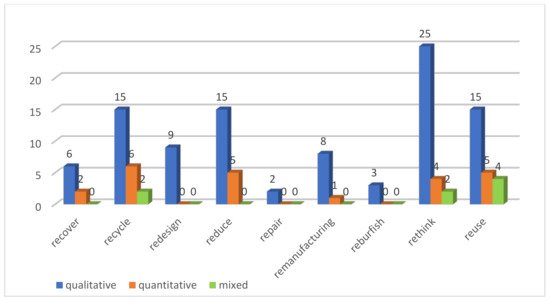 Figure 7. Relationship between methods and CE dimensions.Figure 8 shows the relationship between the stage of the food chain that each article focused on and the CE dimension. The most commonly mentioned CE dimensions were rethink, reuse, and reduce. For household food waste and loss specifically, the findings indicate that all CE dimensions need to be considered and solutions developed in terms of all dimensions.
Figure 7. Relationship between methods and CE dimensions.Figure 8 shows the relationship between the stage of the food chain that each article focused on and the CE dimension. The most commonly mentioned CE dimensions were rethink, reuse, and reduce. For household food waste and loss specifically, the findings indicate that all CE dimensions need to be considered and solutions developed in terms of all dimensions.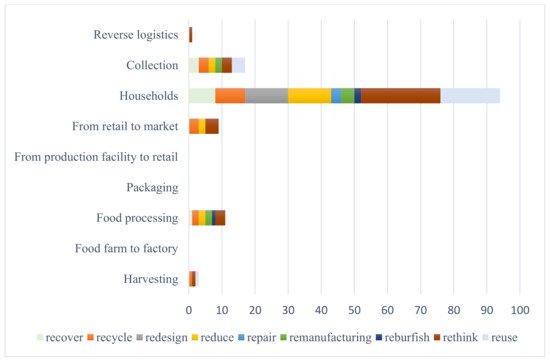 Figure 8. Relationship between stages of food supply chain and CE dimensions.As Figure 9 shows, all food supply chain stages are critical for all of the different sub-sectors.
Figure 8. Relationship between stages of food supply chain and CE dimensions.As Figure 9 shows, all food supply chain stages are critical for all of the different sub-sectors.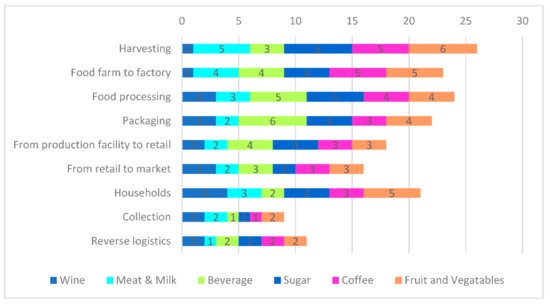 Figure 9. Relationship between sub-sectors and supply chain stages.As shown in Figure 10, the selected articles focused most frequently on “recycle” and “reduce” for all sub-sectors. Apart from these CE dimensions, articles regarding the meat and milk sectors mainly focused on design stage dimensions of “redesign” and “rethink” to decrease food loss and waste. In contrast, no articles considered “repair” and “refurbishment”. This may because reducing and recycling processes are more appropriate for the sampled sub-sectors.
Figure 9. Relationship between sub-sectors and supply chain stages.As shown in Figure 10, the selected articles focused most frequently on “recycle” and “reduce” for all sub-sectors. Apart from these CE dimensions, articles regarding the meat and milk sectors mainly focused on design stage dimensions of “redesign” and “rethink” to decrease food loss and waste. In contrast, no articles considered “repair” and “refurbishment”. This may because reducing and recycling processes are more appropriate for the sampled sub-sectors.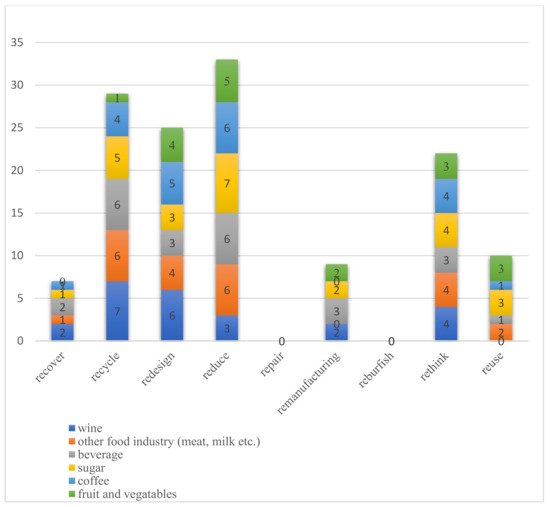 Figure 10. Relationship between sub-sectors and CE dimensions.The findings so far show that researchers have discussed and categorized barriers to implementing CE bin food supply chains in various ways. Araujo Galvão [20] identified seven main barriers: technological, policy and regulatory, financial and economic, managerial, performance indicators, customers, and social. Govindan and Hasanagic [14] identified eight categories: governmental issues, economic issues, technology issues, knowledge issues, management issues, CE framework issues, cultural and social issues, and market issues. Kirchherr et al. [21] identified four categories: culture, regulatory, market, and technology. Ghadge et al. [22] first identified two barriers: internal and external. They then classified them into five different categories: market, regulation, suppliers, operation, and management. Van Keulen and Kirchherr [23] identified four main clusters of barriers in the coffee supply chain: values, technologies, business cases, and governmental policies.Given this literature, the present study considered seven main barriers to CE, as shown in Table 1: “cultural”, “business and business finance”, “regulatory and governmental”, “technological”, “managerial”, “supply-chain management”, “knowledge and skills”.Table 1. Potential barriers of CE in food supply chains.
Figure 10. Relationship between sub-sectors and CE dimensions.The findings so far show that researchers have discussed and categorized barriers to implementing CE bin food supply chains in various ways. Araujo Galvão [20] identified seven main barriers: technological, policy and regulatory, financial and economic, managerial, performance indicators, customers, and social. Govindan and Hasanagic [14] identified eight categories: governmental issues, economic issues, technology issues, knowledge issues, management issues, CE framework issues, cultural and social issues, and market issues. Kirchherr et al. [21] identified four categories: culture, regulatory, market, and technology. Ghadge et al. [22] first identified two barriers: internal and external. They then classified them into five different categories: market, regulation, suppliers, operation, and management. Van Keulen and Kirchherr [23] identified four main clusters of barriers in the coffee supply chain: values, technologies, business cases, and governmental policies.Given this literature, the present study considered seven main barriers to CE, as shown in Table 1: “cultural”, “business and business finance”, “regulatory and governmental”, “technological”, “managerial”, “supply-chain management”, “knowledge and skills”.Table 1. Potential barriers of CE in food supply chains.Barriers Sub-Barriers Author(s) Cultural (B1) Lacking Consumer Awareness and Interest [11,13,24,25,26,27,28,29,30,31,32,33,34,35,36,37,38,39,40,41,42,43,44,45,46,47,48,49,50,51,52]. (B2) Hesitant Company Culture [13,29,30,31,32,53] (B3) Inadequate Knowledge About CE [13,29,30,37,40,41,44,45,47,48,49,53,54,55,56,57,58,59,60,61,62] (B4) Currently Operating in a Linear System [63,64] Business and Business Finance (B5) Weak Economic Incentives [27,41,42,43,44,45,46,47,48,60,65,66] (B6) Major Investment Costs [43,44,47,48,67,68] (B7) High Cost of Receiving Recycling Product [30,31,41,45,47,48,66] (B8) Mismatch between Return and Profit (B9) Increased Research Cost [40,43,47,48] (B10) Limited Business Model Applications [68] [44,46] Regulatory and Governmental (B11) Lack of Conductive Legal Systems [14,24,30,39,41,42,46,47,48,54] (B12) Policy Challenges [11,13,24,25,26,27,28,29,30,31,32,33,34,35,36,37,38,39,40,41,42,43,44,45,46,47,48,49,50,52]. [14,41,45,47,48] (B13) Taxation and Incentives [25,27,36,61,69] (B14) Existing Loose Environmental Regulations (B15) Different Focuses between Central and Local Governments [38,52,70] (B16) Lack of Proper Waste Infrastructure (B17) Lack of Standard System for CE performance [38,42,56,58,59,71,72,73,74] [25,32,38,44,47,48,53,55,56,58,59,71,72,73,74,75,76,77] Technological (B18) Technical Limitations of Recycling [13,30,31,41,44,46,47,48,54,61,65,67] (B19) Need for Data Integration [26,78] (B20) Lack of Eco-efficiency of the Technological Processes [16,41,47,48,54,79] Managerial (B21) Poor Leadership and Management [11,12,25,28,31,32,34,42,44,47,48,80,81,82,83] (B22) Missing Information Exchange [11,47,48] (B23) Lack of Collaboration [12,15,24,34,41,44,45,47,61,76,77,78,80,83] (B24) Higher priority of other issues [47,84] (B25) Ineffective labor [18,68] Supply Chain Management (B26) Lack of Eco-Literacy Among Supply Chain Partners [41,85,86] (B27) Need for a High-Level Supply Chain Integration [11,12,25,28,32,34,35,41,44,47,48,52,71,76,77,81,82,84,85,87,88,89,90,91,92,93,94,95,96,97] (B28) Unavailable Effective Framework Adaptation [48,80,98] Knowledge and Skills (B29) Difficulty in Defining CE [32,44,99,100] (B30) Difficulties in implementation of CE [32,44,47,99,100,101,102,103] More specifically, “cultural barriers” include four different sub-barriers: lack of consumer awareness and interest, inadequate knowledge of CE, hesitant company culture, currently operating in a linear system. The transition to CE requires remarkable cultural changes in company structure. The main barriers to CE implementation are regulatory barriers, which include policy challenges and the lack of a standard system for CE performance and supply, and chain management barriers such as the need for high-level supply chain integration. Moreover, technological investment and development is a significant factor in the transition to CE. Another main barrier is inadequate knowledge and skills. It is therefore important for companies to improve awareness of CE and integrate CE into their supply chains. Supply chain management barriers include a lack of eco-literacy among supply chain partners, the need for a high-level supply chain integration, and ineffective framework adaptation. Business and business finance sub-barriers include weak economic incentives, major investment costs, the high cost of receiving recycling products, a mismatch between return and profit, increased research costs, and limited business model applications. Business and business finance, and managerial barriers are also related to the significant initial investment and widening multi-stakeholder structure in the supply chain during the transition to CE. Increasing complexity and information in the supply chain also create new sub-barriers, such as poor leadership and management, lack of information exchange, lack of collaboration, prioritization of other issues, and ineffective labor.Although some companies find it easier to maintain traditional production and distribution methods, many other companies have begun the CE transition. While some large firms, as well as some start-ups, have begun using CE principles, it will take time to shift the entire corporate culture towards this. In contrast to traditional business models, circular business models require novel cooperation and collaboration methods along the supply chain. Companies should therefore invest and innovate using CE principles. In this regard, it is important to design longer-lived, waste-avoiding products so that it is easy to apply the 9Rs. Accordingly, technical barriers include the transition to CE, technical limitations of recycling, the need for data integration, and lack of eco-efficiency of technological processes.Regarding regulatory and local government barriers, CE implementation requires understanding the various expectations of different actors and clear regulatory standards. Thus, barriers include lack of appropriate legal systems, policy challenges, taxation and incentives, loose environmental regulations, different focuses between central and local governments, lack of proper waste infrastructure, and lack of standard systems for CE performance. Some actors may oppose CE because they profit highly from the existing linear system. Thus, it is crucial to have a clear regulatory framework.Figure 11 shows the interaction between the sub-barriers and the stages of the supply chain. Almost all the articles mentioned various sub-barriers for different stages of the food supply chain, particularly lack of consumer awareness and interest, policy challenges, inadequate knowledge about CE, weak economic incentives, lack of conducive legal systems, lack of standard CE performance systems, technical limitations for CE, and poor leadership and management.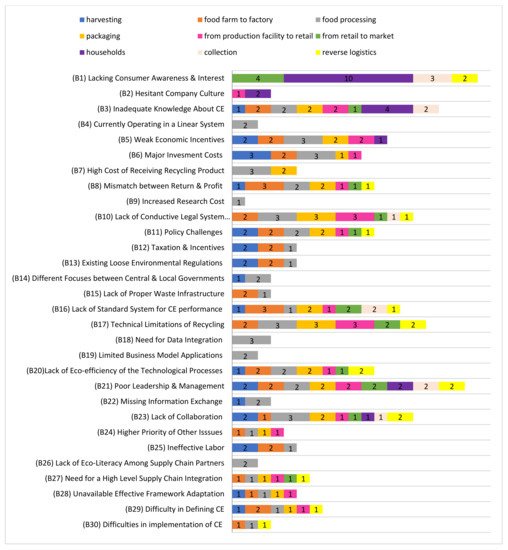 Figure 11. Interaction between sub-barriers and supply chain stages.Figure 12 shows the interaction between sub-barriers and CE dimensions. Rethink and reduce were the most frequently mentioned in the articles CE dimensions for nearly all sub-barriers to implementing CE in the food supply chain, followed by use of recycling.
Figure 11. Interaction between sub-barriers and supply chain stages.Figure 12 shows the interaction between sub-barriers and CE dimensions. Rethink and reduce were the most frequently mentioned in the articles CE dimensions for nearly all sub-barriers to implementing CE in the food supply chain, followed by use of recycling. Figure 14. Interaction between sub-barriers and CE dimensions.
Figure 14. Interaction between sub-barriers and CE dimensions.3. Relationships Between CE and Digital Technologies
Researchers have proposed various Industry 4.0 technologies to overcome the sub-barriers to CE in food supply chains. Digital technologies have various advantages. First, by obtaining real-time information, they can improve performance by ensuring efficient utilization of resources. Second, these technologies can improve the innovation abilities of businesses.Table 2 lists various digital technologies for overcoming CE-related barriers. IoT and barcodes are used to monitor used product parts and materials, obtain all information about products, and reduce product design or quality issues [104]. In the food industry specifically, IoT can reduce food waste and loss through sensors that track conditions in the food supply chain, such as temperature and humidity. Recent studies show that IoT strategies can improve product design and implementation [105]. IoT can also be used to create business models, usage and post-usage improvements, data recording, monitoring of conditions, preventive maintenance, predictions for end-of-life usage, and making effective design decisions [17]. Real time data allow consumers to assess food quality more accurately and create a better health and safety environment since food products usually have short shelf lives. Increasing traceability saves energy in the food supply chain and creates circularity. Digital tools that provide traceability, such as RFID, BDA, and blockchains, can be used for the recovery processes, such as reusing, recycling, and remanufacturing [106]. If all stakeholders can share their data in the supply chain network, then food fraud can be reduced with blockchain technology.Table 2. Proposed digital technologies to deal with barriers related to CE dimensions.CE DIMENSIONS INDUSTRY 4.0 TECHNOLOGIES Reuse CPS, BDA, AI, 3DP, RFID, Barcodes, Nanotechnologies, Blockchain Recycle IoT, CPS, BDA, CC, AI,3DP, RFID, Barcodes, Blockchain Reduce IoT, 3DP Remanufacturing IoT, BDA, CC, AI, 3DP, RFID, Barcodes, Robotics Repair IoT, CPS, BDA, 3DP Recover CC Refurbish CPS, AI Repurpose Machine Learning Rethink AGV, Machine Learning Redesign Iot, AGV, Machine Learning One of the most important causes of food waste is supply-demand imbalance. CPS technology helps suppliers to determine optimum order size by gathering data from transactions and other sources in to accurately monitor in-process inventory [107]. 3DP technology enables the reuse of material for another 3DP process and strengthens the relationship between suppliers and customers [108]. 3DP is a flexible technology, which enables the production of both small batches and complex products at lower cost, fewer materials, and less waste [109]. 3DP technology provides design for circularity and environmentally friendly materials. It enables intelligent packaging for food products by analyzing and indicating the temperature of the product to decrease food waste and loss. Machine learning and AI can be used to overcome the CE barriers in the supply chain by optimizing processes and systems based on large amounts of data in order to repurpose, rethink, and redesign CE dimensions [16]. CC enables sharing of network resources and capabilities in certain supply chain stages, particularly design, manufacture, and assembly of products [110,111]. Robotics provides additional support by supporting processes that require quality production and precision in production. It can therefore be used for remanufacturing processes in the supply chain [112]. Businesses have already used robotics to increase food product consistency and production efficiency. Finally, nanotechnologies, AGV, and machine learning enable materials and components to be recycled in the last stage of product life and reused within the same production system or outside it [113].Table 3 summarizes how Industry 4.0 technologies mentioned in the literature can deal with barriers related to specific CE dimensions. Digital technology tools are proposed for each sub-barrier within the dimensions listed in Table 3.Table 3. Proposed Industry 4.0 technologies to deal with sub-barriers for specific CE dimensions.Main Barriers Sub-Barriers Author(s) CE Dimensions Industry 4.0 Technologies Cultural (B1) Lacking consumer awareness and interest [114,116,119,122,132,136,138,139] Reuse, Recycle, Reduce, Rethink, Remanufacturing, Redesign, Repair, Refurbish IoT, CPS, BDA, CC, AI, 3DP, RFID, Barcodes, Robotics, Blockchains, AGV, Machine learning, Nanotechnology (B2) Hesitant company culture [121,130,132,134,138,140] Reuse, Recycle, Reduce, Remanufacturing, Repair, Refurbish IoT, CPS, BDA, CC, AI, 3DP, RFID, Barcodes, Robotics, Blockchains, Nanotechnology (B3) Inadequate knowledge about CE [118,127,132,138,141] Reuse, Recycle, Reduce, Remanufacturing, Repair, Refurbish, Rethink IoT, CPS, BDA, CC, AI, 3DP, RFID, Barcodes, Robotics, Blockchains, AGV, Machine learning, Nanotechnology (B4) Currently operating in a linear system [123,129,132,135,140] Reuse, Reduce, Rethink IoT, CPS, BDA, AI, 3DP, RFID, Barcodes, Blockchains, AGV, Machine learning, Nanotechnology Business and Business Finance (B5) Weak economic incentives [121,128,132,136,138,139] Reuse, Recycle, Reduce, Remanufacturing, Repair, Refurbish, Rethink, Redesign IoT, CPS, BDA, CC, AI, 3DP, RFID, Barcodes, Robotics, Blockchains, AGV, Machine learning, Nanotechnology (B6) Major investment costs [129,139] Repurpose, Rethink AGV, Machine Learning (B7) High cost of receiving recycling product [128,140] Rethink AGV, Machine Learning (B8) Mismatch between return and profit [128,129] Rethink AGV, Machine Learning (B9) Increased research cost [128,141] Repurpose, Rethink AGV, Machine Learning (B10) Limited business model applications [132,135,137,141] Repair, Rethink IoT, CPS, BDA, 3DP, AGV, Machine learning Regulatory and Governmental (B11) Lack of conductive legal systems [108,117,120,128,130,132,138] Reuse, Recycle, Reduce, Remanufacturing, Repair, Refurbish, Rethink IoT, CPS, BDA, CC, AI, 3DP, RFID, Barcodes, Robotics, Blockchains, AGV, Machine learning, Nanotechnology (B12) Policy challenges [116,119,125,131,132,133,138] Reuse, Recycle, Reduce, Remanufacturing, Repair, Recover, Refurbish, Rethink, Redesign IoT, CPS, BDA, AI, 3DP, CC, Blockchains, Robotics, AGV, Machine Learning (B13) Taxation and incentives [115,116,127,128,129,132,136,138] Reuse, Recycle, Reduce, Rethink IoT, CPS, BDA, CC, AI, 3DP, RFID, Barcodes, Robotics, Blockchains, AGV, Machine learning, Nanotechnology (B14) Existing loose environmental regulations [116,126,131,132,134,138,139] Reuse, Recycle, Reduce, Recover, Rethink IoT, CPS, BDA, CC, AI, 3DP, RFID, Barcodes, Robotics, Blockchains, AGV, Machine learning, Nanotechnology (B15) Different focuses between central and local governments [116,124,129,132,135,138] Reuse, Recycle, Reduce, Remanufacturing, Repair, Rethink IoT, CPS, BDA, CC, AI, 3DP, Robotics, Blockchains, AGV, Machine learning (B16) Lack of proper waste infrastructure [116,129,137] Rethink, Reduce IoT, AGV, 3DP, Machine learning (B17) Lack of standard system for CE performance [116,120,123,129,132,135,138] Reuse, Recycle, Reduce, Remanufacturing, Recover, Refurbish, Rethink IoT, CPS, BDA, CC, AI, 3DP, RFID, Barcodes, Robotics, Blockchains, AGV, Machine learning, Nanotechnology Technological (B18) Technical limitations of recycling [121,132,137,138,139] Reuse, Recycle, Reduce, Remanufacturing, Repair, Refurbish, Rethink, Redesign IoT, CPS, BDA, CC, AI, 3DP, RFID, Barcodes, Robotics, Blockchains, AGV, Machine learning, Nanotechnology (B19) Need for data integration [132,133,134,141] Reuse, Recycle, Reduce, Rethink IoT, CPS, BDA, CC, AI, 3DP, RFID, Barcodes, Blockchains, AGV, Machine learning, Nanotechnology (B20) Lack of eco-efficiency of the technological processes [120,123,129,132,137,138] Reuse, Recycle, Remanufacturing, Rethink IoT, CPS, BDA, CC, AI, 3DP, RFID, Barcodes, Robotics, Blockchains, AGV, Machine learning, Nanotechnology Managerial (B21) Poor leadership and management [116,132,136,138,140] Reuse, Recycle, Reduce, Remanufacturing, Repair, Recover, Rethink IoT, CPS, BDA, CC, AI, 3DP, RFID, Barcodes, Robotics, Blockchains, AGV, Machine learning, Nanotechnology (B22) Missing information exchange [115,116,132,138,140] Reuse, Recycle, Remanufacturing, Repair IoT, CPS, BDA, CC, AI, 3DP, RFID, Barcodes, Robotics, Blockchains, Nanotechnology (B23) Lack of collaboration [108,114,116,132,138] Reuse, Recycle, Reduce, Rethink, Redesign IoT, CPS, BDA, CC, AI, 3DP, RFID, Barcodes, Blockchains, AGV, Machine learning, Nanotechnology (B24) Higher priority of other issues [128,129,141] Rethink AGV, Machine learning (B25) Ineffective labor [131,132,139] Repurpose, Rethink AGV, Machine learning Supply chain management (B26) Lack of eco-literacy among supply-chain partners [129,132,141] Reuse, Recycle, Reduce, Rethink IoT, CPS, BDA, CC, AI, 3DP, RFID, Barcodes, Blockchains, AGV, Machine learning, Nanotechnology (B27) Need for a high-level supply chain integration [114,132,135,138,141] Reuse, Recycle, Reduce, Remanufacturing, Repair, Recover, Rethink IoT, CPS, BDA, CC, AI, 3DP, RFID, Barcodes, Robotics, Blockchains, AGV, Machine learning, Nanotechnology (B28) Unavailable effective framework adaptation [132,133,135,140] Reuse, Recycle, Reduce, Rethink IoT, CPS, BDA, CC, AI, 3DP, RFID, Barcodes, Blockchains, AGV, Machine learning, Nanotechnology Knowledge and Skills (B29) Difficulty in defining CE [132,138,140] Reuse, Recycle, Reduce, Remanufacturing, Refurbish, Repurpose, Rethink IoT, CPS, BDA, CC, AI, 3DP, RFID, Barcodes, Robotics, Blockchains, AGV, Machine learning, Nanotechnology (B30) Difficulties in implementation of CE [123,132,134,136,138] Reuse, Recycle, Reduce, Remanufacturing, Refurbish, Rethink IoT, CPS, BDA, CC, AI, 3DP, RFID, Barcodes, Robotics, Blockchains, AGV, Machine learning, Nanotechnology IoT, RFID, and Barcodes provide various advantages such as improved food supply chain transparency, improved inventory management by tracking the entire process, and enabling of real-time data for the food supply chains such as temperature and moisture [108,114,115]. By increasing transparency and collaborations in the food supply chain, IoT and RFID can be overcome regulatory and governmental barriers listed in Table 4. Besides, food supply chain transparency becomes a significant issue for the food supply chain because of the short shelf life since consumers want to know the process of products and choose a more environmentally friendly product [116,117,118]. Thus, IoT, RFID, and Barcodes are beneficial to deal with lacking consumer awareness and interest and inadequate knowledge about CE.In addition, blockchain technology and CC enable the creation of a traceable and transparent food supply chain that increases trust between farmers, retailers, suppliers, and consumers, thus reducing food fraud [119,120,121]. Therefore, these technologies can overcome barriers related to regulatory and governmental issues. Blockchain technology can deal with the lack of collaboration and missing information exchange and weak economic incentives through increasing transparency [122,123,124]. Besides, an ascending collaboration between partners has led to increasing food supply chain practices, strategies, production processes [125,126,127].Machine learning, AI, and CPS technology provide an increase in financial performances for each actor along the food supply chain [128] by enabling a higher degree of supply chain integration due to its multi-stakeholder structure and also contributing to the increase of environmental sustainability of the food supply chain [129,130]. Therefore, it is useful for dealing with financial challenges and ineffective labor in the transition to CE [131,132]. Moreover, big data are used to accurately forecast consumer demand and purchases by supporting increased coordination in the food supply chain in order to overcome data integration barriers in the food supply chain [133,134]. These technologies create new business models aimed at increasing the profitability of the company by reshaping its food supply chain operations. Thus, these technologies became a highly effective solution to dealing with the barriers faced by company cultures in transitioning to CE [135]. 3DP technology can reduce production costs by increasing production efficiency and by providing customized food product manufacturing [136]. 3DP technology enables the advantages of low cost and simple and rapid prototyping compared to traditional methods for the production of food materials. Thus, it is beneficial for dealing with the technical limitations of recycling and the lack of eco-efficiency of the technological processes [137].AGV and Robotics help to achieve the goals of consumers and regulators to reduce food contamination and improve food safety [138]. These technologies enhance flexibility and can be used for multiple tasks in order to deal with the need for a high-level supply chain integration and difficulties in knowledge and skills.Figure 13 presents the suggested Industry 4.0 technologies for each CE sub-barrier in the food supply chain, shown in Table 2. The barriers can be overcome with proposed Industry 4.0 technologies to transition to CE within food supply chains. Figure 13. Interaction between sub-barriers and Industry 4.0 technologies.
Figure 13. Interaction between sub-barriers and Industry 4.0 technologies.
This entry is adapted from the peer-reviewed paper 10.3390/su13126812
This entry is offline, you can click here to edit this entry!
